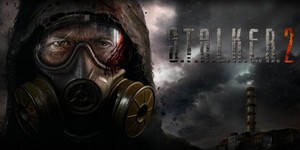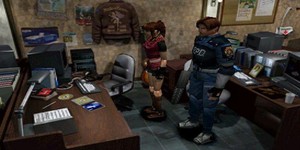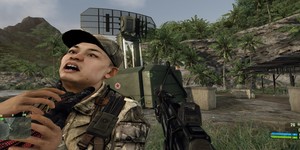Ten Years On: S.T.A.L.K.E.R: Shadow of Chernobyl
March 22, 2017 | 10:20
Companies: #cd-projekt #gsc-game-world

We’ve seen many-a wilderness represented in the years since Shadow of Chernobyl, but I think only CD Projekt has managed to match GSC’s talent for infusing that weird and unknowable personality into landscape art. At times that eeriness elevates into outright terror, such as when you’re chased around a hillside by an invisible Bloodsucker mutant, or when you delve into one of the Zone’s anomaly-filled subterranean facilities.
It’s also in the Garbage where Shadow of Chernobyl’s A-Life system reveals its potential. Prior to writing this article, I went back to the game for a quick refresher course, and even in the few hours I played, I experienced three or four fantastic systems-driven encounters. In one, a herd of mutant creatures crashed a firefight between myself and a group of bandits inside the railway depot. One mutant chased a lone bandit into an open cargo carriage, and moments later I distantly heard the bandit’s scream as he was savaged by the monster.
Bullets don’t only fly when you’re around either. Your exploration of the Zone is regularly accompanied by the distant sound of lead-based arguments. There’s something curiously enjoyable about hearing gunfire in the vicinity and rushing over to join in the fray, or even better, arriving after the last bullet has been fired and piecing together precisely what happened.
As a shooter, STALKER stands up remarkably well, mainly thanks to its heavy emphasis on authentic bullet simulations and tricky enemy AI. While not spectacular, STALKER’s firefights are gritty and ferocious, and bear more than a passing resemblance to combat in the ArmA series. Only a fraction of bullets fired ever hit their mark, but they cause a huge amount of damage when they do. Enemies don’t stand around waiting to be shot, either. They weave in and out of cover, retreat when under sustained fire, and constantly attempt to flank you. I also want to give special mention to STALKER’s grenades, which accurately convey just how dangerous these weapons are. Grenade blasts aren’t localised to a few feet, they spit shrapnel across tens of metres of ground, peppering distant enemies with wounds and obliterating anyone closer.
Beyond the underwhelming opening and those disappointments of yore, Shadow of Chernobyl is still a pretty great FPS. Determining whether it’s worth playing today is made tricky, however, by the legacy of games it left in its wake. There’s no question that Shadow’s successor, Call of Pripyat, is the superior game. Not only does it have much larger areas to explore, it reintroduces many of the mechanics that were cut from Shadow of Chernobyl, and improves many other areas of the game, including the A-Life simulation. It also actually lets you explore Pripyat itself, unlike Shadow of Chernobyl which forces you to rush through the abandoned city during the game’s atrocious ending.
Yet regardless of whether Shadow of Chernobyl is worth playing compared to its sequels, it’s still a significant entry in the PC gaming canon. It possesses one of the most interesting settings of any FPS, and the way it wrestles with the concept of open-world shooting paved the way for other games such as the Far Cry sequels. Like the dark and inhospitable world it portrays, Shadow of Chernobyl is a bizarre yet beautiful mess.
It’s also in the Garbage where Shadow of Chernobyl’s A-Life system reveals its potential. Prior to writing this article, I went back to the game for a quick refresher course, and even in the few hours I played, I experienced three or four fantastic systems-driven encounters. In one, a herd of mutant creatures crashed a firefight between myself and a group of bandits inside the railway depot. One mutant chased a lone bandit into an open cargo carriage, and moments later I distantly heard the bandit’s scream as he was savaged by the monster.
Bullets don’t only fly when you’re around either. Your exploration of the Zone is regularly accompanied by the distant sound of lead-based arguments. There’s something curiously enjoyable about hearing gunfire in the vicinity and rushing over to join in the fray, or even better, arriving after the last bullet has been fired and piecing together precisely what happened.
As a shooter, STALKER stands up remarkably well, mainly thanks to its heavy emphasis on authentic bullet simulations and tricky enemy AI. While not spectacular, STALKER’s firefights are gritty and ferocious, and bear more than a passing resemblance to combat in the ArmA series. Only a fraction of bullets fired ever hit their mark, but they cause a huge amount of damage when they do. Enemies don’t stand around waiting to be shot, either. They weave in and out of cover, retreat when under sustained fire, and constantly attempt to flank you. I also want to give special mention to STALKER’s grenades, which accurately convey just how dangerous these weapons are. Grenade blasts aren’t localised to a few feet, they spit shrapnel across tens of metres of ground, peppering distant enemies with wounds and obliterating anyone closer.
Beyond the underwhelming opening and those disappointments of yore, Shadow of Chernobyl is still a pretty great FPS. Determining whether it’s worth playing today is made tricky, however, by the legacy of games it left in its wake. There’s no question that Shadow’s successor, Call of Pripyat, is the superior game. Not only does it have much larger areas to explore, it reintroduces many of the mechanics that were cut from Shadow of Chernobyl, and improves many other areas of the game, including the A-Life simulation. It also actually lets you explore Pripyat itself, unlike Shadow of Chernobyl which forces you to rush through the abandoned city during the game’s atrocious ending.
Yet regardless of whether Shadow of Chernobyl is worth playing compared to its sequels, it’s still a significant entry in the PC gaming canon. It possesses one of the most interesting settings of any FPS, and the way it wrestles with the concept of open-world shooting paved the way for other games such as the Far Cry sequels. Like the dark and inhospitable world it portrays, Shadow of Chernobyl is a bizarre yet beautiful mess.

MSI MPG Velox 100R Chassis Review
October 14 2021 | 15:04

![Ten Years On: S.T.A.L.K.E.R: Shadow of Chernobyl [TUESDAY 21st] Ten Years On: S.T.A.L.K.E.R: Shadow of Chernobyl](http://images.bit-tech.net/content_images/2017/03/ten-years-on-stalker/stalker5-614x345.jpg)
![Ten Years On: S.T.A.L.K.E.R: Shadow of Chernobyl [TUESDAY 21st] Ten Years On: S.T.A.L.K.E.R: Shadow of Chernobyl](http://images.bit-tech.net/content_images/2017/03/ten-years-on-stalker/stalker6-614x345.jpg)
![Ten Years On: S.T.A.L.K.E.R: Shadow of Chernobyl [TUESDAY 21st] Ten Years On: S.T.A.L.K.E.R: Shadow of Chernobyl](http://images.bit-tech.net/content_images/2017/03/ten-years-on-stalker/stalker7-614x345.jpg)
![Ten Years On: S.T.A.L.K.E.R: Shadow of Chernobyl [TUESDAY 21st] Ten Years On: S.T.A.L.K.E.R: Shadow of Chernobyl](http://images.bit-tech.net/content_images/2017/03/ten-years-on-stalker/stalker8-614x345.jpg)








Want to comment? Please log in.